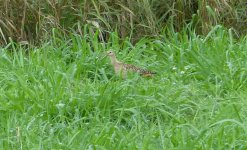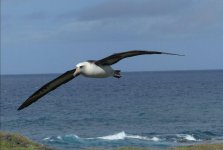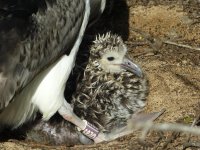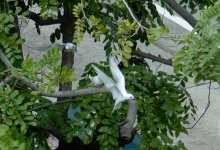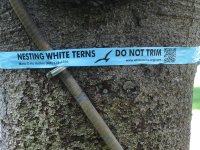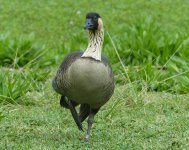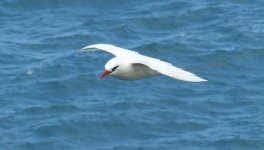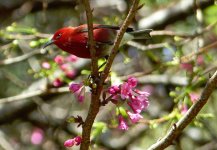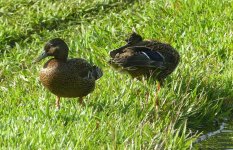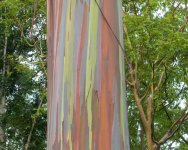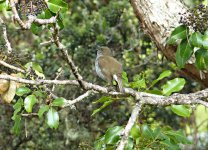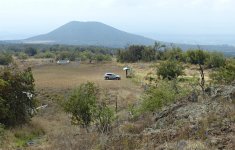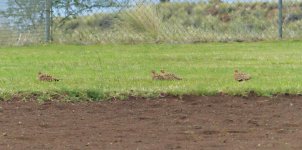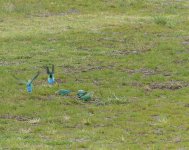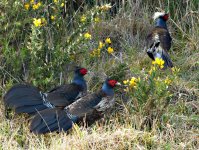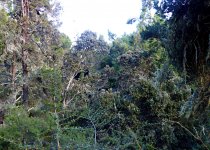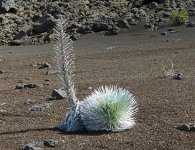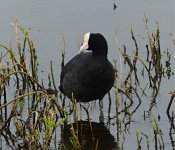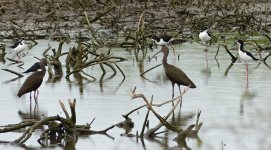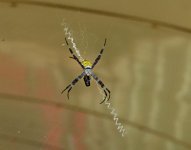
Hawaii is not a classical birders' paradise, and my report supports this. However, the islands do offer a number of fascinating aspects, most of all those "honeycreepers" that are actually finches. And then, there is a mix of seabirds and migrants that can't impress by numbers but for other reasons. And finally, among the large number of introduced species, some have their own potential to attract special attention.
In February 2018, we visited four of the main islands, Oahu, Kauai, Big Island and Maui in this sequence, spending five nights on each of them. This meant four full days plus a variable amount of observation time on the travel days. Thus, we did not really have a lot of time on each island, but nevertheless sufficient to provide time for a decent impression. February is definitely not the optimal time for those who want to spend a lot of time at the beaches. There was usually a chilly wind that made us wonder why so many tourists walked around in short sleeves and short pants. Well, we are of the older generation, thus having a less optimized thermoregulation than younger people. But nevertheless, we often felt people simply clothed the way they did because they wanted to celebrate that holiday feeling. February is also in the rainy season, and that affects the windward sides i.e. the eastern parts in particular.
February is also in the rainy season, and that affects the windward sides i.e. the eastern parts in particular.
Anyway, February was the compromise for me that allowed to shorten our northern (Swiss) winter and to still have a very good chance for Bristle-thighed Curlew at the convenient Oahu wintering grounds. It was also clear that with regards to sea-birds there is no time of the year when they all breed. There is a clear separation in time so as to reduce competition between the species. But with the breeding season of the Laysan Albatross during the time of our visit, I felt I could do with less of the other species (no other tubenoses and essentially no terns).
Fortunately, there were still guided tours offered at Oahu's James Campbell NWR. They close the refuge during the breeding season of the Hawaiian Stilt. Thus the last possibility would have been February 17. Tours are only offered twice a week, and for us that meant driving up from Honolulu on the first morning. It's about a 90 minute drive, and the tour began at 9 AM. Thus a very convenient start of our Hawaii experience. Bristle-thighed Curlews breed in a small part of western Alaska, but they winter essentially spread out over much of the central Pacific. Every year, they need to find those islands that are mere specks in the wide expanse of the ocean. It's just this odd way of making a living that has totally fascinated me for a long time. Thus, the species was one of my most wanted birds for this trip. I was particularly intrigued by learning how they seem pretty much separated on the refuge by each individual having its own winter territory on the short-cut vegetation where they forage for crayfish. That curved somewhat delicate looking bill would not seem to be optimal for such prey, yet the curlews seem to do just fine.
Another Oahu highlight for us were the nesting Laysan Albatross at Kaena Point. Some already had small young. Though I wonder where the majority of the reported over 100 nests were. Is the great majority on the upper plateau? We did get a thorough drenching on the way to the colony, to the point where I then had to replace my watch as the battery compartment was no longer water tight. Good thing there was a Swatch store near our hotel. The walk out to Kaena Pt. and back was harder than I expected, in particular because of the sticky mud on the road that we did not manage to get rid of easily. I definitely should not have taken my scope out there! Just too much weight for a 75 year old guy who is not the sportsy type to begin with.
The third Oahu highlight for us were the White Terns that we could watch from the hotel balcony. Once again, they became our instant favorite town birds. We had seen them on Australia's Lord Howe Island ten year ago, possibilities for close observations were actually better there. But that's a detail, we were just happy to see these neat birds again. White Terns only nest in Honolulu, no place else on the main Hawaiian islands. The terns nest on branches of the city trees, and there is now a movement to protect them from maintenance activities. Thus, nesting trees are marked with a blue ribbon around the trunk saying "do not trim".
Unfortunately, we had a hotel room that was infested with bed bugs, but by the time we realized what was going on, our stay was almost over and we preferred to keep the room just because of the terns! Before, we had thought we got some sand flees or whatever. The bites took 10 days and more to heal.
Due to the limited time, we did not explore the Oahu forests at all as it was not my goal to get as many species as possible. Rather, I tried to see a variety of the bird life, with some preferences, of course.
I'll continue as time permits. So this is just part one.
In February 2018, we visited four of the main islands, Oahu, Kauai, Big Island and Maui in this sequence, spending five nights on each of them. This meant four full days plus a variable amount of observation time on the travel days. Thus, we did not really have a lot of time on each island, but nevertheless sufficient to provide time for a decent impression. February is definitely not the optimal time for those who want to spend a lot of time at the beaches. There was usually a chilly wind that made us wonder why so many tourists walked around in short sleeves and short pants. Well, we are of the older generation, thus having a less optimized thermoregulation than younger people. But nevertheless, we often felt people simply clothed the way they did because they wanted to celebrate that holiday feeling.
Anyway, February was the compromise for me that allowed to shorten our northern (Swiss) winter and to still have a very good chance for Bristle-thighed Curlew at the convenient Oahu wintering grounds. It was also clear that with regards to sea-birds there is no time of the year when they all breed. There is a clear separation in time so as to reduce competition between the species. But with the breeding season of the Laysan Albatross during the time of our visit, I felt I could do with less of the other species (no other tubenoses and essentially no terns).
Fortunately, there were still guided tours offered at Oahu's James Campbell NWR. They close the refuge during the breeding season of the Hawaiian Stilt. Thus the last possibility would have been February 17. Tours are only offered twice a week, and for us that meant driving up from Honolulu on the first morning. It's about a 90 minute drive, and the tour began at 9 AM. Thus a very convenient start of our Hawaii experience. Bristle-thighed Curlews breed in a small part of western Alaska, but they winter essentially spread out over much of the central Pacific. Every year, they need to find those islands that are mere specks in the wide expanse of the ocean. It's just this odd way of making a living that has totally fascinated me for a long time. Thus, the species was one of my most wanted birds for this trip. I was particularly intrigued by learning how they seem pretty much separated on the refuge by each individual having its own winter territory on the short-cut vegetation where they forage for crayfish. That curved somewhat delicate looking bill would not seem to be optimal for such prey, yet the curlews seem to do just fine.
Another Oahu highlight for us were the nesting Laysan Albatross at Kaena Point. Some already had small young. Though I wonder where the majority of the reported over 100 nests were. Is the great majority on the upper plateau? We did get a thorough drenching on the way to the colony, to the point where I then had to replace my watch as the battery compartment was no longer water tight. Good thing there was a Swatch store near our hotel. The walk out to Kaena Pt. and back was harder than I expected, in particular because of the sticky mud on the road that we did not manage to get rid of easily. I definitely should not have taken my scope out there! Just too much weight for a 75 year old guy who is not the sportsy type to begin with.
The third Oahu highlight for us were the White Terns that we could watch from the hotel balcony. Once again, they became our instant favorite town birds. We had seen them on Australia's Lord Howe Island ten year ago, possibilities for close observations were actually better there. But that's a detail, we were just happy to see these neat birds again. White Terns only nest in Honolulu, no place else on the main Hawaiian islands. The terns nest on branches of the city trees, and there is now a movement to protect them from maintenance activities. Thus, nesting trees are marked with a blue ribbon around the trunk saying "do not trim".
Unfortunately, we had a hotel room that was infested with bed bugs, but by the time we realized what was going on, our stay was almost over and we preferred to keep the room just because of the terns! Before, we had thought we got some sand flees or whatever. The bites took 10 days and more to heal.
Due to the limited time, we did not explore the Oahu forests at all as it was not my goal to get as many species as possible. Rather, I tried to see a variety of the bird life, with some preferences, of course.
I'll continue as time permits. So this is just part one.
Attachments
Last edited:




